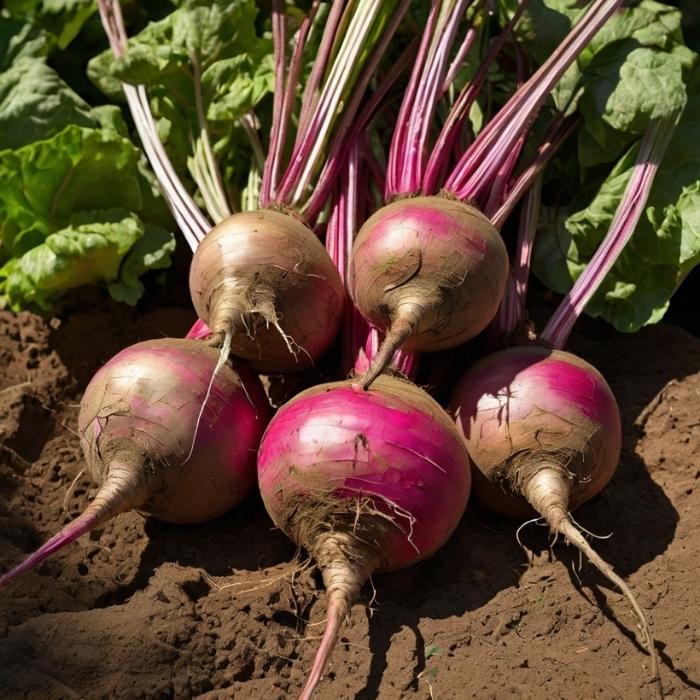The Vibrant World of Chioggia Beets: A Gardener’s Delight
Chioggia beets, with their striking concentric rings of red and white, are a feast for the eyes and the palate. Originally from the coastal town of Chioggia in Italy, these heirloom vegetables have gained popularity among gardeners and chefs alike for their unique appearance, sweet flavor, and versatility in the kitchen. In this guide, we’ll delve into the history, cultivation, nutritional benefits, and culinary uses of Chioggia beets, ensuring you have all the information you need to grow and enjoy this colorful root vegetable.
A Brief History of Chioggia Beets
candy-striped beets, sometimes referred to as “candy-striped” or “Bull’s Eye” beets, trace their origins back to the 19th century in Chioggia, a small fishing village in Northern Italy. These beets were introduced to the rest of Europe and eventually to North America, where they became a beloved heirloom variety. Unlike traditional red candy-striped beets are prized for their mild, sweet flavor and visually stunning appearance.
Why Choose Chioggia Beets for Your Garden?
Chioggia beets are not only a culinary delight but also a gardener’s favorite. Here’s why:
- Quick Growing Cycle: These beets mature in as little as 55 days, making them a great choice for gardeners looking for a fast harvest.
- Adaptability: candy-striped beets thrive in a variety of climates and soil conditions, provided they are well-drained and rich in organic matter.
- Dual Purpose: Both the roots and the leafy greens are edible, offering a two-in-one crop.
- Visual Appeal: Their unique candy-striped interior adds a wow factor to salads and dishes, making them a favorite among chefs.
How to Grow Chioggia Beets
Growing Chioggia beets is straightforward, even for novice gardeners. Follow these steps for a successful harvest:
1. Soil Preparation
- Chioggia beets prefer loose, sandy loam soil with a pH between 6.0 and 7.5.
- Enrich the soil with compost or well-rotted manure before planting.
- Remove any rocks or debris to ensure the roots grow without obstruction.
2. Planting
- Sow seeds directly into the garden bed once the soil temperature reaches at least 50°F (10°C).
- Plant seeds ½ inch deep and 1 inch apart in rows spaced 12 inches apart.
- Thin seedlings to 3-4 inches apart once they emerge to allow proper root development.
3. Watering and Care
- Water consistently, ensuring the soil remains moist but not waterlogged.
- Mulch around the plants to retain moisture and suppress weeds.
- Fertilize with a balanced fertilizer once or twice during the growing season.
4. Harvesting
- Harvest Chioggia beets when they reach 2-3 inches in diameter for the best flavor and texture.
- Gently pull them from the soil, taking care not to damage the delicate roots.
Nutritional Benefits of Chioggia Beets
Chioggia beets are a nutritional powerhouse, offering numerous health benefits. Here’s a breakdown of their key nutrients:
- Rich in Antioxidants: The vibrant pigments in candy-striped beets are packed with betalains, which have anti-inflammatory and antioxidant properties.
- High in Fiber: A single serving provides a good amount of dietary fiber, promoting healthy digestion.
- Packed with Vitamins and Minerals: Chioggia beets are an excellent source of folate, manganese, potassium, and vitamin C.
- Low in Calories: With just 40 calories per 100 grams, they’re a great addition to any diet.
Culinary Uses for Chioggia Beets
Chioggia beets’ mild flavor and vibrant color make them incredibly versatile in the kitchen. Here are some popular ways to enjoy them:
1. Raw in Salads
- Slice Chioggia beets thinly to showcase their candy-striped pattern and toss them with a light vinaigrette.
- Combine with arugula, goat cheese, and walnuts for a refreshing salad.
2. Roasted
- Roasting enhances their natural sweetness. Cut them into wedges, drizzle with olive oil, and roast at 400°F (200°C) for 25-30 minutes.
3. Pickled
- Pickling Chioggia beets is a great way to preserve them and add tangy flavor to sandwiches or charcuterie boards.
4. Steamed or Boiled
- Steam or boil candy-striped beets until tender, then serve with a sprinkle of sea salt and a drizzle of balsamic glaze.
5. Juices and Smoothies
- Add candy-striped beets to your favorite juice or smoothie recipes for a nutrient boost and a touch of natural sweetness.
Common Challenges and Solutions
Like any crop, candy-striped beets come with their own set of challenges. Here are some common issues and tips to address them:
1. Poor Germination
- Ensure soil temperatures are optimal (50°F to 85°F).
- Soak seeds in water for a few hours before planting to improve germination.
2. Pests
- Watch for common beet pests like leaf miners and aphids.
- Use floating row covers or introduce beneficial insects like ladybugs to control infestations.
3. Disease
- Avoid overwatering to prevent fungal diseases like downy mildew.
- Rotate crops each year to reduce the risk of soil-borne diseases.
Why You Should Try candy-striped beets Today
Chioggia beets are more than just a pretty vegetable. They’re a testament to nature’s artistry and a flavorful addition to any meal. Whether you’re a seasoned gardener or just starting, candy-striped beets are a rewarding crop that will elevate your garden and your plate. With their quick growing cycle, nutritional benefits, and versatility in the kitchen, there’s no reason not to give them a try.

